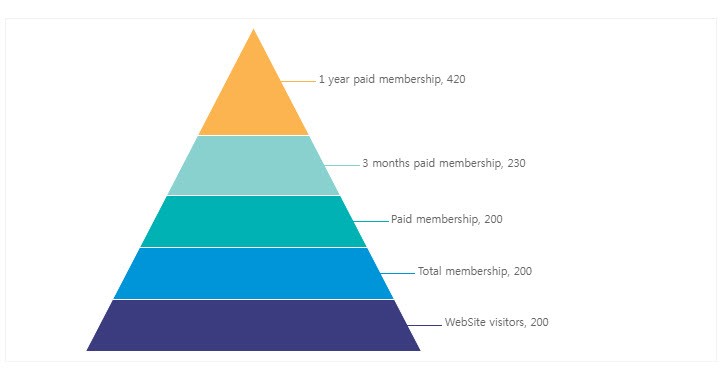When working with data, there are many ways you can organize or display it. Finding the right way to present your data, so that it is most useful to whatever operation you’re working on, is a necessary skill for anyone working in the field. However, with so many options, it can be difficult to be aware of them all or identify the best type of chart for your specific needs. Fortunately, there are resources available that can help you understand many common charts, including pyramid charts. If you’re interested in learning more, keep reading to find out what a pyramid chart is and how they can be used.
Table of Contents
What exactly is a pyramid chart?
There are a wide range of charts and ways to sort data, but some are more widely used than others. One common way to organize data is through a pyramid chart. So, what is a pyramid chart? A pyramid chart is a graphical tool that is used to display the relative proportions of different values. The chart is made up of a series of stacked rectangles, with the largest rectangle at the bottom and the smallest at the top. The height of each rectangle is proportional to the value that it represents.
Pyramid charts are a type of data visualization tool that uses a triangular shape to represent the hierarchical relationship between data points. The widest point of the triangle represents the root data point, while the points at the top of the triangle represent the data points that are subordinate to the root data point. This type of chart is ideal for visualizing the relative proportions of data points at each level of a hierarchy.
There are several advantages to using pyramid charts. For one, they are simple and easy to understand. They can be used to deliver a straightforward message that is supported both in text and visually. They can fill specific niches that other charts may not be able to. This is primarily due to the fact that there aren’t a large number of graphical ways to illustrate a hierarchy.
How are pyramid charts used?
Practically, they can be used in a variety of ways and providing pyramid charting functionality is becoming a priority for many tech companies and service providers. Pyramid charts can be used in business to help managers track the progress of their team or department. They can also be used to track the steps of a project. In government, they can be used to monitor the output of different legislative initiatives. They can also be used to measure the progress of different government agencies. Educators also use pyramid charts to create a data visualization that represents student performance.
In marketing, pyramid charts have multiple use cases. They can track the success of the campaign using whatever metrics the business stipulates. Sales from various product lines are another type of data that can be visualized through the creation of a pyramid chart. Scientific researchers use pyramid charts too. Research projects can have their progress displayed in a way that provides maximum utility. These charts are used across scientific disciplines and are often an essential resource for those who are engaged in highly sensitive and detailed research. Best of all, they’re able to do so in a way that is easy for anyone to interpret.
As you can see, pyramid charts can useful for sorting and analyzing complicated hierarchies. They enable businesses to present this data to coworkers, clients, and potential partners. Generally, data visualization has become increasingly important in fields like business, education, science, and marketing. Creating them can take skill, and every chart relies on having a quality data set to input. However, when used properly, pyramid charts can be a great tool for businesses and organizations of all kinds.
What Is a Pyramid Chart?
What Is a Pyramid Chart? The Pyramid chart is a diagram that displays data in a hierarchical manner. It is often used in surveys to visually represent data about age and sex. You can also use the pyramid chart to represent market segments, such as age and sex. Read on to learn more about how to create one. Here are some tips to create your own pyramid chart. Firstly, choose a topic. Once you’ve chosen your topic, you should decide how many subcategories you’d like to use. If there are too many subcategories, the pyramid chart will appear cluttered and complicated. Remember to organize your subcategories in a hierarchy, with the most important ones at the bottom and the smallest ones at the top. Lastly, label your subcategories so that they reflect the topic you’re considering
Pyramid charts are a visual representation of data in a hierarchical way
A pyramid chart shows the relationship between two sets of data. The bars of a pyramid chart are triangular and are proportional to the data points they represent. The data points at the base of the chart are much larger than those on top, and vice versa. This arrangement allows the viewer to compare two sets of data without having to read lengthy texts or try to make sense of the underlying data. Pyramid charts are useful for illustrating changes in data and showing the relative size of each group.
They are often used in surveys
There are two main types of pyramid charts. The first one is the classic pyramid chart, which is also called a layered or hierarchical chart. The other type is known as an alternative pyramid chart, which is very common and is a popular alternative to a pyramid chart. In both types of charts, data are grouped in categories. The subcategories are arranged in hierarchical order, with the most important ones on the bottom and the smallest ones at the top. Then, the pyramid chart is divided into layers, each section labeled. Finally, the chart should reflect the topic being studied.
They can be used to visualize age-sex data
If you are looking for a way to visualize age-sex data, you can use Pyramid charts. This type of chart can be generated by selecting the Age-Race-Gender data from your database. To start creating a pyramid, choose the Main Menu and click ChartGraphics>PopulationPyramids. This menu provides access to charts and other visual representations of the subject matter data.
They can be used to represent market segments
A pyramid chart is a visual representation of the hierarchy of items. The DIKW pyramid represents the functional relationship between Data, Information, and Knowledge, with labels placed on the outside and inside the sections of the pyramid. It is also often used to represent Maslow’s Hierarchy of Needs, which concerns the workplace environment and self-actualization. Each section is categorized according to its importance. For example, a customer might want a certain product in a particular color, and that is represented by an inverted pyramid.
They can be used to display percent values instead of numerical values
A pyramid chart is a visually appealing way to display data, often for geographic purposes. Its shape resembles a pyramid and displays data in groups with different sizes and shapes. This kind of chart also helps people to understand large amounts of data quickly. The key difference between a pyramid chart and a bar chart is the way the points are arranged. A pyramid chart shows a hierarchy, and it is useful when data is organized in levels.












